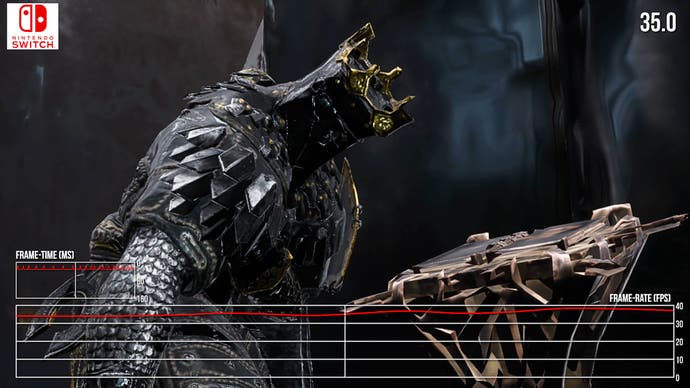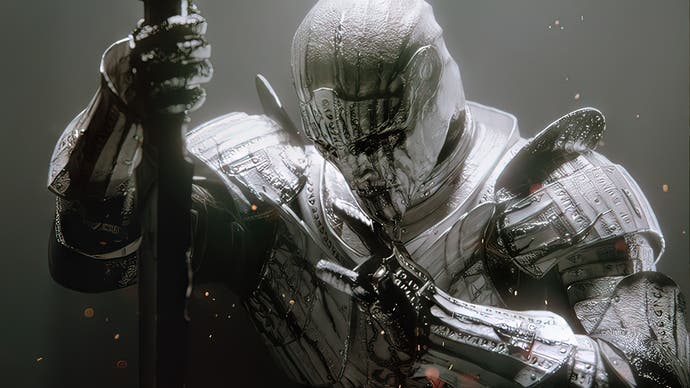Mortal Shell on Nintendo Switch: an ambitious port with big performance problems
Shellshock.
With a surprise late 2022 release on the Nintendo Switch eShop, Mortal Shell: Complete Edition gives Switch users the full package; a complete port of the 2020 Souls-like, with all DLC and content updates included. At first glance Mortal Shell on Switch actually looks like a success. In much the same vein as other Unreal 4 titles like Mortal Kombat 11, the visual make-up - the core details of the action - translate well to Switch, but having spent the last week this portable release I've got to say there are glaring issues. Specifically, hitting such an ambitious bar of quality comes at a cost to its frame-rate and so it follows, also its playability. The impact is so striking that at times, the Switch version is a genuine struggle to control.
To cut to the chase, compared to the PS4 release from 2020, Mortal Shell on Switch is an obvious downgrade in key areas, though it seems that some elements of the lighting may hail from a more modern build of the codebase PS4 was never updated to. Starting at the top though, you'll notice texture assets are dropped in resolution. Notably the floors, or walls of dungeons, often manifest as a blurry smudge if viewed too close. The best theory is Switch's 4GB of RAM is the limiting factor here - though certain points do still get priority for high quality textures. So for example, character texture-work is identical to PS4's. Armour sets - the so-called 'shells' - are crisply defined in close-up, as is the weaponry. Even cloth physics stay enabled on Switch as we walk the world, with cloaks, draping flags and more billowing dynamically. But yes, the environmental detail does take a serious cutback in select spots.
A few other downgrades stick out. Grass foliage density and draw distance on trees is cut back, while water ripple physics are completely gone on Switch, the only thing left behind being the transparency effects for caustics and splashes as we walk through. Added to that, screen-space reflections are dropped in accuracy too, meaning fewer on-screen elements factor into the final mirror image. In fairness though? SSR is definitely engaged, and all things considered it's impressive it makes the cut at all.
Even with these cutbacks, Switch does a remarkable job in retaining a lot of the detail, effects and features of the PS4 release. Motion blur effects are included, while mist, fog, and other atmospheric effects roll across the distance. Ambient occlusion is enabled, too, adding shading to its world. Pop-in is surprisingly minimal as we run through detail-dense areas as well, though the contained level design helps there. Yes, the cutbacks are easy to pick out: the depth of field effect removed, the volumetric lighting reduced in resolution , creating obvious stairsteps to light shafts. Plus, dynamic shadows, while near torchlight appear to be missing on Switch. Even so, Switch has all the core content, and offers the framework of the world design that makes Mortal Shell enjoyable.
Resolution-wise, there's a difference too. PS4 runs at a dynamic 900p, using temporal reconstruction to deliver a 1080p output. As for Switch while docked, we get a reconstructed 720p image instead- though the typical native resolution is between 540p and 600p to my count - typically resting at that 1066x600 mark. As far as its docked play goes, the Unreal Engine TAA does a surprisingly great job of reconstructing the frame. Moving onto portable mode, we get a range between 360p and 400p, looking at the raw pixel structures. But, again, all of this reconstructs via TAA to 720p, matching the handheld's screen. All other visual settings appear identical to the docked experience otherwise - it's just the resolution range that changes.


This all sets the stage for the contentious point of Switch's performance, where we should point out the scale of the challenge facing the port. After all, the PS4 version targets 30fps but has issues in achieving this: there's aggressive screen-tearing, there's uneven frame-pacing, and there are huge stutters in streaming. Switch has its own issues, starting with a lack of a 30fps cap, meaning a frame-rate range of anything between 10fps and 60fps. Typically, we're at between 15-40fps for the run of play. So, the marshland areas in Fallgrim usually play out in this range, making inputs for simple navigation or weapon strikes less responsive. In fact, there are entire sections across one later dungeon which flow at a near constant 15-20fps. Here, putting too many enemies on-screen seems to be the culprit. Portable play is much the same: we're still in a similar 15-40fps range, usually centring on the mid-20s and under during combat.
Another key performance point in a Souls-like concerns loading times, owing to the amount of times you're likely to die then reload. There's some good news here as Switch is not only competitive with PS4, but actually faster in some cases. The one caveat is Switch goes through a lengthy initial load to boot the game itself - an astonishing 100 second wait up against 40 seconds on PS4. The good news is that Switch's suspend and resume feature bypasses all of this anyway. After the initial load, Switch improves on PS4's loading times, by a few seconds. It's not snappy by any means, but usually you're expecting a wait of 21 seconds on Switch after dying and waiting to respawn up against around 26 seconds on PS4.
The verdict for Mortal Shell on Switch is mixed. It's an ambitious port but once again we're faced with software that's dying for a Switch successor to run it well. And thanks to its unlocked frame-rate, it'll be a great title to test, if and when new hardware appears - assuming back-compat works and boosts performance. As it is though, while the visual cutbacks are expected next to PS4, the resulting frame-rate on Switch simply isn't good enough. An evenly paced 30fps cap might help some points - but with so much play languishing under 30fps and even 20fps, the benefits there will be limited. If you're looking for a taxing Switch port - a title that goes beyond its means with the GPU power on tap, Mortal Shell is fascinating to try as an experiment. However, to play and enjoy the experience developer Cold Symmetry has created, there are far better versions out there to check out first.


